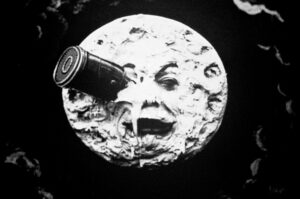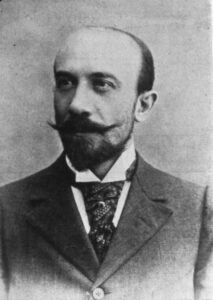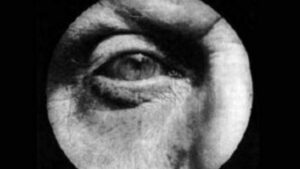Silent Film – Fairgrounds

Silent film history – “A Trip to the Moon”
The period of fair cinema and then the works of the Brighton School filmmakers mark the most important achievements of silent film in the first two decades since its birth.
Fairground cinema – the Lumière brothers and Georges Méliès
In the history of cinema, the years 1895 – 1908 are called the stage of fair or primitive cinema. This refers to the films of Louis Lumière and Gerges Méliès. Lumier’s works still lack action, the camera is stationary, and his films are often referred to as “moving pictures.” Lumiere was primarily interested in genre scenes, such as a young child’s lunch (“Breakfast”) or a train entering a train station (“Arrival of a Train”). The beginnings of a plot, on the other hand, can be seen in “L’arroseur arose”. That’s where the first gag, a sudden change in the plot, appears.
Georges Méliès, on the other hand, is an incredibly interesting case of a filmmaker whose main love was the theater of illusion. When Paris’s most famous illusionist, Robert Houdin, retired from the profession in 1855, Méliès took over the theater after him and developed it in a way that the master himself certainly would not have been proud of. His performances drew crowds, and cinema became for Méliès a form of variety for the stage show.
The filmmaker’s first films also recorded magic tricks, such as “The Vanishing Lady” at the Robert Houdin Theater. The role of this lady was played by Méliès’ later wife, Jehanne d’Aley, referred to as the “first film star” for this reason. The French director, thanks to his experiments, first introduced cinematic tricks into cinema, such as turning a man into a woman.

Georges Méliès
Méliès’ silent films, on the other hand, make cinema a spectacle for the first time. His works are no longer about the faithful registration of reality, but about the creation of a completely new cinematic world. Thus, for the first time there is an idea, a plot, a script and a director. Méliès also created the first film studio, STAR FILM. The director is also the creator of three film genres: feria, actuality and film fantasy.
Feeria, or Miracles and Wonders, are registrations of illusionist plays, and are also silent films based on magical themes. We can mention “The Vanishing Lady”, “Cinderella” or “The 400 Tricks of the Devil”. News, on the other hand, have the character of a paradoukment, in which actors act out real scenes, such as a royal coronation (The Coronation of Edward VII). Fanatasticism, on the other hand, includes works based on themes of science-fiction literature and scientific discovery. Examples include “A Trip to the Moon”, “The Impossible Voyage” or “The Conquest of the Pole”.
The first silent films were very short, for the first five years of cinema’s existence they lasted only 3 minutes. At that time the technique of superimposed photography was used. Initially, entrepreneurs bought films on their own and exploited them as much as possible; hence the analogy to a traveling circus.
Brighton School

Grandma’s Reading Glass
A milestone in the development of silent cinema was undoubtedly the achievements of the so-called Brighton School, a group of English photographers. They were Georg Albert Smith, James Williamson and William Paul. It is these film personalities who are considered the creators of the first montage. This is because they were the initiators of the division of one scene into separate shots. In addition, and the great achievement of the Brighton School was the introduction of the close-up, or so-called grand plan.
It was in Smith’s films that for the first time a face or a hand could occupy the entire screen. The filmmakers initially took care to adequately motivate such a procedure, using, for example, binoculars through which the protagonist looks or a magnifying glass. Filmmakers of the aforementioned school also began for the first time to compose the frame, that is, the smallest part of the film. As examples of works, it is worth mentioning “Grandma’s Reading Glass”.
